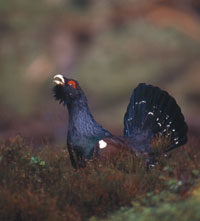 I spent much of last week in the beautiful surroundings of the Cairngorms National Park in Scotland, on a recce for this year’s Autumnwatch, investigating a story about deer. It’s a stunning landscape, with vast sweeping vistas of forests, mountains and lochs. The air was crystal clear and from the top of the Cairn Gorm Mountain Railway the views were spectacular. It just felt so wild and untouched. But of course, it’s not, far from it.
I spent much of last week in the beautiful surroundings of the Cairngorms National Park in Scotland, on a recce for this year’s Autumnwatch, investigating a story about deer. It’s a stunning landscape, with vast sweeping vistas of forests, mountains and lochs. The air was crystal clear and from the top of the Cairn Gorm Mountain Railway the views were spectacular. It just felt so wild and untouched. But of course, it’s not, far from it.The wildlife value of the modern forest is risible. They are a monoculture little better than the giant fields of grain crops you find further south in Britain. The thick dark canopy of needles allows no light onto the forest floor here, which consists of a barren carpet of dead needles. Nothing can really exist at all.
Compare that to what should be the natural habitat, the Caledonian Pine Forest, and the difference is astonishing . Here Scotts Pine trees are beautifully spaced and layered with a mix of old and new that allow light to flood to the floor, encouraging a wealth of plants like blaeberry and heathers to flourish. The biodiversity of these places is just as nature intended, rich, diverse and beautiful. Tantalising species like Pine Martens, Capercaillie, Cross Bills, Crested Tits and of course the charming red squirrels, make up an A-list of wildlife superstars that call this habitat home.
It can be a depressing trudge around the highlands looking and hoping for a glimpse of this rare Caledonian Forest habitat, it’s just so rare to find it. But, some places offer a much better chance than others of finding it. And those places exist thanks to our relatives in the Victorian Age. They created a classic example of Accidental Nature.
You see it was the Victorians who really got excited by hunting. It became a really big hit with the social climbers of this world. Hunting deer, grouse and salmon was the thing to do. And the thing to have if you had the money wasn’t a yacht at the Cannes Film festival or a villa in Monaco for the Grand Prix. No, the thing to have was a hunting estate.
Huge areas of natural habitat where prey species flourished, i.e. the Caledonian Forest and moors, were shielded away from the local crofters who were otherwise turning these places into farmland. This land grab may well be wholly socially unacceptable, but effectively back then it created giant nature reserves. They didn’t have the regulation of today’s safe hideaways, and the animals were shot and killed, but a large proportion of the habitat that the Victorian’s hived away for their own sporting gains, still remains today. And obviously the animals being hunted were never allowed to die out, because that would have defeated the purpose of owning the hunting estate. So, today these estates represent many of the best examples of Caledonian Forest that we have left, along with strong populations of the species that live in it.
One particular estate, Kinveachy, at 33000 acres in size, is one of the very best examples of this Accidental Nature reserve. It holds maybe 10% of Scotland’s Capercaillie population and it’s where last year I filmed Britain rarest mammal, the Scottish Wildcat.
It’s carefully run by Sporting Manger, Frank Law, who has to play a delicate balance between his hunting clients and the needs of what has now been classed a European Special Area of Conservation. Talking to Frank there seems no doubt in his mind just how important the wildlife is, and he’s exceptionally proud of what the estate represents for nature. What’s more he is absolutely convinced that if it wasn’t for the Victorians and their love of killing things, very little of the Caledonian Forest would be there today. And as hunting still plays a key part of the estate’s income, hunting is still important in keeping the Caledonian Forest as it is and helps pay for the increasing amount of conservation work that is now carrying out.
It would be good to imagine a future where hunting is no longer needed on the estate. But how strange that the remaining wilderness of today in the Cairngorms has depended on humans desire to kill animals. I guess when it comes to Accidental Nature we can never be sure how our actions of today will unfold for the natural world of the tomorrow.
To see more of Kinveachy visit http://www.strathspey-estate.co.uk/conservation.php







No comments:
Post a Comment